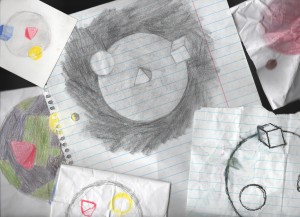Essay by Ludwig Wergenergener, Ph.D. (Oxon.), Dip. Ed.(Utrecht), D.Sc. (Knutsford); as provided by Darren Goossens
Illustration by Justine McGreevy
The Discovery: In the year 34.6 (2207 by the old calendar), the planet of Bruce was discovered. It was named after Bruce Fingleton, who found it one morning on his mail run in between Norman Street and Arthurton Street, Melbourne, Australia, where previously a dog-biscuit factory had been located. This was to prove significant. The planet was soon successfully identified as spherical and in fact in orbit around Canis Major, something that Bruce had apparently failed to notice. Its appearance in between Norman Street and Arthurton Street was put down to it having never been seen before–logically, it was pointed out that since the planet had not, until Bruce’s fortuitous happenstance, been observed, no-one had the right to say where it had or had not been.
#
The Expedition: Three years after Bruce’s discovery, an expedition to Bruce was launched. A small misunderstanding resulted in a Mark IVb Series 2 Interplanetary Exploration Vessel (the Fibonacci Munro, 2.4 million tonnes, extremely gross) crashing through the front porch of Mr. Bruce Fingleton’s house, killing Mr. Bruce Fingleton, his family, and all his neighbours out to a six mile radius. After an appropriate memorial service, a grease and oil change, and the construction of a brand new housing development, the Fibonacci Munro was relaunched, this time in a considerably more upward direction.

Unlike other planets, it has seven geographic poles, each more inaccessible than the last (though only if you visit them in the correct order). Like Earth, it has exactly two magnetic poles, but, rather inconveniently, they are both at the same end. This causes the average magnetic compass to undergo what can only be described as a nervous breakdown.
To read the rest of this story, check out the Mad Scientist Journal: Summer 2012 collection.
Prof. Ludwig Wergenergener has a D. Phil. in Bovine Husbandry (Oxon.) and three gold stars for colouring inside the lines (Knutsford North Preschool). His work on waterproof cheese was described by the President of the Royal Society as ‘filling a much-needed gap in the scientific literature’. His selection for the first manned expedition to another planet was controversial but certain, given the photographs he obtained of the key members of the selection panel at their New Year’s BBQ (throwing, as they do, a new light on the Chair of the Panel’s battle for legalisation of interspecies marriage). His subsequent history is perhaps too well known to bear repeating here; suffice to say that the Eurovision Song Contest will never be the same again.
Apart from interpreting Professor Wergenergener’s writings and presenting them to the public, Darren has published fiction in Aurealis and Andromeda Spaceways, amongst other magazines, and some allegedly humorous drawings in NFG magazine.
Justine McGreevy is a slowly recovering perfectionist, writer, and artist. She creates realities to make our own seem slightly less terrifying. Her work can be viewed at http://www.behance.net/Fickle_Muse and you can follow her on Twitter @Fickle_Muse.
Follow us online: